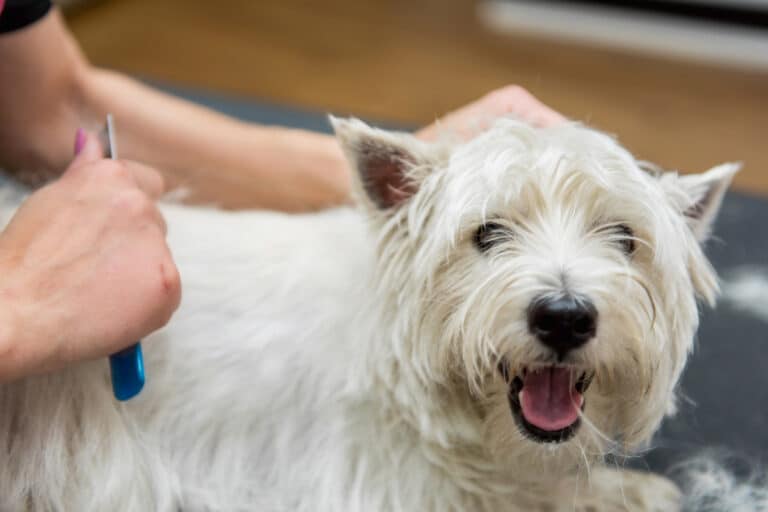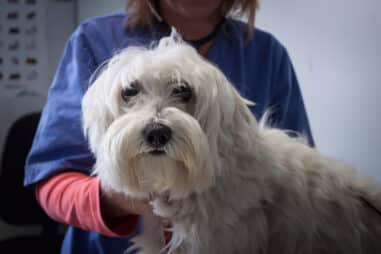The Westie’s double coat consists of a wiry topcoat and a soft, dense undercoat. Aside from a good coat texture, you may also want to maintain its vibrant white color. Finding a professional groomer specializing in Terrier coats will be helpful.
Are West Highland Terriers Low Maintenance?
Caring for a Westie is a relatively low-maintenance job. Although they require daily brushing, it can be an easy chore. Since your dog’s coat is short, it is not tangle-prone. Furthermore, their double coat is not prone to shedding. There is no need to worry about white hairs on your furniture.
Do West Highland White Terriers Have Hair or Fur?
West Highland White Terriers have both hair and fur. Their undercoat is a fleece-like fur. You can find these on their skin, especially along their bellies. The top layer is longer and rougher guard hair. It helps to protect and keep the undercoat clean.
How to Groom a West Highland White Terrier
To keep your West Highland White Terrier happy and healthy, follow the grooming steps below:
- Brush your westie’s coat every day.
- Clip or strip your west highland white terrier’s coat regularly.
- Bathe your furball once every few weeks.
- Clean your westie’s ears.
- Cut your west highland white terrier’s nails.
- Brush your pet’s teeth daily.
Brush Your Westie’s Coat Every Day.
Doing this keeps your pet’s fur clean and allows its skin to breathe. Your dog’s coat will also look its best. When brushing, do it in sections and be gentle. Ensure that you’re using a brush that is made for your dog’s thick hair. Give treats and praises right after brushing.
Clip or Strip Your West Highland White Terrier’s Coat Regularly.
Decide whether you want to clip or strip your dog. Regular clipping or stripping will remove dead hairs. It will keep your furball’s coat looking shiny. You can do it yourself or bring your pet to a professional groomer.
Clipping involves the use of electric clippers. If you clip your Westie’s entire coat, it grows a soft and short coat. On the other hand, stripping is done by removing dead hairs using your fingers. Also called hand stripping, it is more popular with show dog owners. It produces a coarse and wavy coat.
Bathe Your Furball Once Every Few Weeks.
Unless your pet has a skin issue, bathe it once a month or less. Doing this will help keep your Westie’s skin healthy and its coat shiny and full. After a trim is also a good time to bathe your dog as it helps remove cut and loose hair.
Be aware that bathing your Westie too frequently may cause skin problems such as dryness. This is because bathing strips off its natural skin oils.
Never use human shampoo on your dog. It can be too harsh on its skin and may even cause its coat to become pink. Essentially, choose a mild shampoo formulated for dogs. Find high-quality shampoos at pet shops and from the vet’s office.
It is best to use a handheld showerhead for bathing your Westie. A pitcher or a large cup also works. Place a rubber mat on the floor so your pet does not slip. Test the water to make sure it is warm. If it feels comfortable, it should be okay for your dog.
After wetting, shampoo your Westie’s fur. Work it in as you avoid its face, especially the eyes. Then rinse out the shampoo. Ensure to rinse all areas you put shampoo on. You’ll know you rinsed enough if the water no longer has suds.
Your West Highland White Terrier is ready for drying. Wrap it up in a towel to dry its coat off. You may also opt to finish drying quickly by using a pet dryer.
Clean Your Westie’s Ears.
In your dog’s routine checkups, the vet will assess the health of its ears. Between these visits, clean your West Highland White Terrier’s ears. You can do it occasionally or if they seem dirty. Do this after your vet has shown you how to do it properly.
Slightly dip a cotton ball in mineral oil, hydrogen peroxide, or a canine ear-cleansing solution. Refrain from inserting any object into your furball’s ear canal. Avoid doing it too deeply or frequently, as it irritates delicate skin.
If you see growing hairs from your Westie’s ears, ask your vet if it’s okay to tweeze them. Else, these may cause tangles and other problems.
Cut Your West Highland White Terrier’s Nails.
Use canine nail clippers. It would be best to trim your terrier’s nails whenever they’ve grown too long. Doing this helps prevent breaking and infection. Long nails also cause your pup to develop an irregular gait.
Be careful when cutting your dog’s nails. Avoid cutting too close to the quick. The quick is the blood vessel in the nail. Doing this grooming task after a bath is ideal as it will make the quick more visible. Applying baby oil to the nail will also do the trick.
If your Westie hates nail trimming, never force it. Let it calm down, and try again later. You may take it to the professional groomer or the veterinarian for nail-cutting sessions.
Brush Your Pet’s Teeth Daily.
A daily toothbrushing session is required to keep your Westie’s teeth and mouth clean. Regular veterinarian visits can help keep periodontal diseases at bay.
Use a pet toothbrush, gauze pad, or a finger cot to brush your dog’s teeth. A toothbrush made especially for pets is essential. These are soft and contoured to the shapes of your canine’s mouth. Similarly, apply a toothpaste formulated for dogs. Human toothpaste or baking soda may contain chemicals that can harm your Westie.
Coat the teeth with toothpaste before brushing gently and slowly. Do this daily for 30 seconds per side of your canine companion’s mouth.
How Often Should a West Highland Terrier Be Groomed?
Besides brushing your Westie’s hair daily, you should ideally groom them once a week. If you have puppies, start them young with two-to-three-minute grooming sessions. Clip out-of-place hairs and check their ears.
How Do You Trim a West Highland White Terrier?
Your West Highland White Terrier would usually need a heavy-duty clipper. Trimmers would be used for small areas such as its feet, between paw pads, around the face, ears, eyes, rectum, genitals, armpits, and abdomen.
Trimmers are used on tight areas that are hard to reach with the larger clipper blade. Since a trimmer cuts closer than a clipper, be careful when using a trimmer to avoid accidental cuts on your dog’s skin.
Remove the hair around its eyes, nose, and mouth. Do this every three to four months or if your furball’s hair grows quickly. Keep them short to avoid trouble when your pet is eating or drinking. Doing this will also keep its line of vision clear. You may also use blunt-tipped scissors or mini-clippers for this task.
How to Cut a West Highland White Terrier’s Hair
A West Highland White Terrier breed has a thick pure-white coat. Grooming and cutting are integral to keeping your pet’s double coat in a top-notch state. These will prevent matting, allow them to see better, and make them stand out from the crowd!
Together with a wide-toothed comb and a clipper, you can use a pair of scissors to cut parts of its hair for a more natural look.
Start with the ears and face. Comb the fur around the head, then pull the hair away from the body. Cut the hair while curving it around the face. Leave approximately an inch of hair at the base of its ear for a rounded look.
To remove hair that sticks out of line, use a pair of texturizing scissors after lifting your pet’s ear. Doing this will allow you to see hair that comes across the ear.
You can use the texturizing scissors again to trim away some of the long hairs around its eyes. Your Westie typically has hair that fans out from their eyes. These protect them when they dig. Cutting these gives your pet a clear line of sight.
On your pet’s short nose, comb the fringe down and cut it halfway along the nose. Cut the hair until you can see their eyes.
Do the same on the sides of the head, the jawline, and the chin. Fluff the fur, comb them upwards, then cut out sections that stray away. Work in a curve while aiming for a circle at every angle. Your texturizing scissors will be very helpful in achieving your Westie’s shape.
Do West Highland Terriers Need to Be Clipped?
West Highland Terriers usually have longer coats than some of the other terriers. Regular brushing and clipping are helpful to prevent tangles, knots, and matting.
Clipping will shorten your Westie’s coat. But it will still be at risk of matting if you won’t remove the old, dead hairs. These should be removed before you clip by hand stripping or deshedding.
Remember that if you decide to clip your West Highland White Terrier’s coat, it will take time to get it back to its length and coarseness. Whatever length you choose to cut your dog’s hair, stick to a routine of brushing and combing it.
Over time, clipping creates a softer coat. It maintains your pet’s fur to be neat and healthy. Plus, it can also make your dog’s hair thicker.
How to Hand Strip a West Highland White Terrier?
Hand stripping is a process that is popular with breeds having wire coats. It involves pulling out the dead and loose hair by hand. The process allows a new harsh wire coat to grow out.
The West Highland White Terriers need hand stripping to achieve the proper texture for their breed coat standard. A common misconception about hand stripping is that it hurts your dog. When done correctly, this grooming step may actually be enjoyable for your canine.
Be careful since you may injure your dog and damage its coat if you improperly execute the process. Learn to do it yourself by watching professional groomers do it. You may want to find one who specializes in terrier breeds.
Hand strip your furball’s coat every four to six weeks by hand. Carefully lift a tuft of the hair, then pull it down to remove the dead and loose hairs from the undercoat. Apply grooming chalk on your fingers to get a good grip on your pet’s hair.
Should you prefer, you may also use a stripping comb. Comb downward in the direction of your Westie’s hair growth. Be careful not to pluck out too much hair. You might make uneven or bald spots.
The stripping process doesn’t have to be completed in one go. Pull excess hair gently and repeatedly from your Westie’s coat a little bit every day. Doing this regularly will ensure that your canine’s coat is firm and straight as it grows back naturally.
How Do I Keep My West Highland Terrier White?
As an owner of a West Highland White Terrier, you are responsible for maintaining its purely white coat. It would help if you learned about simple strategies to avoid coat staining and discoloration.
- Brush your Westie’s coat daily. It will keep the outer coat clean. Brushing also makes the skin secrete oils, which helps to keep the scalp healthy and the hair shiny.
- From time to time, massage white-powdered chalk or cornstarch into your dog’s coat. Leave it on for 10 to 15 minutes. It will absorb grease, dust, and dirt from the fur. With a pin brush, comb out the powder from the coat.
- Avoid bathing your Westie too frequently. Do so at most once a month to prevent drying the skin. Use a dog shampoo specially formulated for dogs with a white coat.
- Always clean the area around the eyes. Ocular discharges such as tears may cause brown to red stains. Use an excellent tear-stain remover or milk of magnesia if you have it in your home.
- Minerals in unfiltered water may cause staining. You may want to give your pup purified water. Also, wipe its mouth after drinking. If its jaw and chin hairs are always wet, bacteria and yeast growth may result in discoloration.
- For your Westie’s feeding paraphernalia, choose to use ceramic bowls. If they’re made of metal and begin to rust, it can cause stains on your dog’s jaw hairs.
- After an outing in the snow, wash your pet’s paws in soapy water. Road salt may cause discoloration.
- Your dog’s coat is a reflection of its overall health. Untreated skin infections and other medical conditions may also cause disturbances on your pup’s skin and coat. That is why routine health checks with your vet are beneficial.





